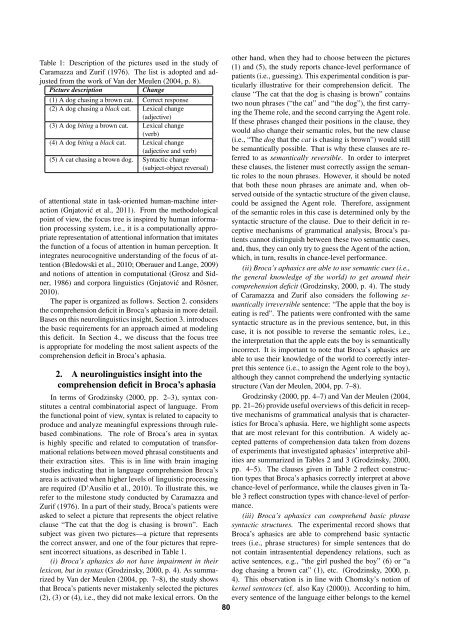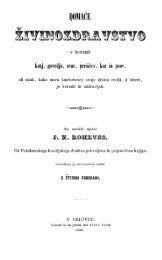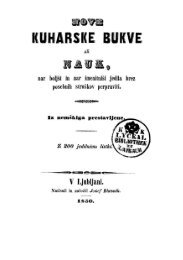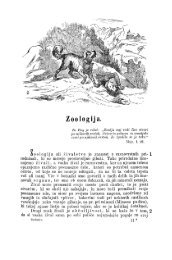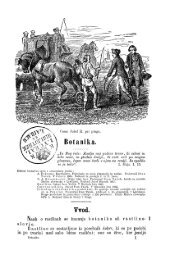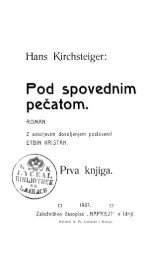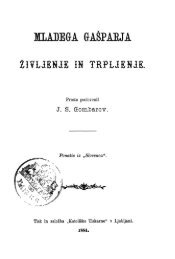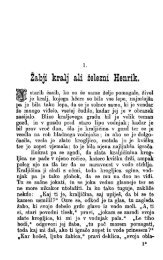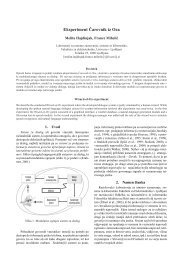Proceedings - Natural Language Server - IJS
Proceedings - Natural Language Server - IJS
Proceedings - Natural Language Server - IJS
Create successful ePaper yourself
Turn your PDF publications into a flip-book with our unique Google optimized e-Paper software.
Table 1: Description of the pictures used in the study of<br />
Caramazza and Zurif (1976). The list is adopted and adjusted<br />
from the work of Van der Meulen (2004, p. 8).<br />
Picture description Change<br />
(1) A dog chasing a brown cat. Correct response<br />
(2) A dog chasing a black cat. Lexical change<br />
(adjective)<br />
(3) A dog biting a brown cat. Lexical change<br />
(verb)<br />
(4) A dog biting a black cat. Lexical change<br />
(adjective and verb)<br />
(5) A cat chasing a brown dog. Syntactic change<br />
(subject-object reversal)<br />
of attentional state in task-oriented human-machine interaction<br />
(Gnjatović et al., 2011). From the methodological<br />
point of view, the focus tree is inspired by human information<br />
processing system, i.e., it is a computationally appropriate<br />
representation of attentional information that imitates<br />
the function of a focus of attention in human perception. It<br />
integrates neurocognitive understanding of the focus of attention<br />
(Bledowski et al., 2010; Oberauer and Lange, 2009)<br />
and notions of attention in computational (Grosz and Sidner,<br />
1986) and corpora linguistics (Gnjatović and Rösner,<br />
2010).<br />
The paper is organized as follows. Section 2. considers<br />
the comprehension deficit in Broca’s aphasia in more detail.<br />
Bases on this neurolinguistics insight, Section 3. introduces<br />
the basic requirements for an approach aimed at modeling<br />
this deficit. In Section 4., we discuss that the focus tree<br />
is appropriate for modeling the most salient aspects of the<br />
comprehension deficit in Broca’s aphasia.<br />
2. A neurolinguistics insight into the<br />
comprehension deficit in Broca’s aphasia<br />
In terms of Grodzinsky (2000, pp. 2–3), syntax constitutes<br />
a central combinatorial aspect of language. From<br />
the functional point of view, syntax is related to capacity to<br />
produce and analyze meaningful expressions through rulebased<br />
combinations. The role of Broca’s area in syntax<br />
is highly specific and related to computation of transformational<br />
relations between moved phrasal constituents and<br />
their extraction sites. This is in line with brain imaging<br />
studies indicating that in language comprehension Broca’s<br />
area is activated when higher levels of linguistic processing<br />
are required (D’Ausilio et al., 2010). To illustrate this, we<br />
refer to the milestone study conducted by Caramazza and<br />
Zurif (1976). In a part of their study, Broca’s patients were<br />
asked to select a picture that represents the object relative<br />
clause “The cat that the dog is chasing is brown”. Each<br />
subject was given two pictures—a picture that represents<br />
the correct answer, and one of the four pictures that represent<br />
incorrect situations, as described in Table 1.<br />
(i) Broca’s aphasics do not have impairment in their<br />
lexicon, but in syntax (Grodzinsky, 2000, p. 4). As summarized<br />
by Van der Meulen (2004, pp. 7–8), the study shows<br />
that Broca’s patients never mistakenly selected the pictures<br />
(2), (3) or (4), i.e., they did not make lexical errors. On the<br />
other hand, when they had to choose between the pictures<br />
(1) and (5), the study reports chance-level performance of<br />
patients (i.e., guessing). This experimental condition is particularly<br />
illustrative for their comprehension deficit. The<br />
clause “The cat that the dog is chasing is brown” contains<br />
two noun phrases (“the cat” and “the dog”), the first carrying<br />
the Theme role, and the second carrying the Agent role.<br />
If these phrases changed their positions in the clause, they<br />
would also change their semantic roles, but the new clause<br />
(i.e., “The dog that the cat is chasing is brown”) would still<br />
be semantically possible. That is why these clauses are referred<br />
to as semantically reversible. In order to interpret<br />
these clauses, the listener must correctly assign the semantic<br />
roles to the noun phrases. However, it should be noted<br />
that both these noun phrases are animate and, when observed<br />
outside of the syntactic structure of the given clause,<br />
could be assigned the Agent role. Therefore, assignment<br />
of the semantic roles in this case is determined only by the<br />
syntactic structure of the clause. Due to their deficit in receptive<br />
mechanisms of grammatical analysis, Broca’s patients<br />
cannot distinguish between these two semantic cases,<br />
and, thus, they can only try to guess the Agent of the action,<br />
which, in turn, results in chance-level performance.<br />
(ii) Broca’s aphasics are able to use semantic cues (i.e.,<br />
the general knowledge of the world) to get around their<br />
comprehension deficit (Grodzinsky, 2000, p. 4). The study<br />
of Caramazza and Zurif also considers the following semantically<br />
irreversible sentence: “The apple that the boy is<br />
eating is red”. The patients were confronted with the same<br />
syntactic structure as in the previous sentence, but, in this<br />
case, it is not possible to reverse the semantic roles, i.e.,<br />
the interpretation that the apple eats the boy is semantically<br />
incorrect. It is important to note that Broca’s aphasics are<br />
able to use their knowledge of the world to correctly interpret<br />
this sentence (i.e., to assign the Agent role to the boy),<br />
although they cannot comprehend the underlying syntactic<br />
structure (Van der Meulen, 2004, pp. 7–8).<br />
Grodzinsky (2000, pp. 4–7) and Van der Meulen (2004,<br />
pp. 21–26) provide useful overviews of this deficit in receptive<br />
mechanisms of grammatical analysis that is characteristics<br />
for Broca’s aphasia. Here, we highlight some aspects<br />
that are most relevant for this contribution. A widely accepted<br />
patterns of comprehension data taken from dozens<br />
of experiments that investigated aphasics’ interpretive abilities<br />
are summarized in Tables 2 and 3 (Grodzinsky, 2000,<br />
pp. 4–5). The clauses given in Table 2 reflect construction<br />
types that Broca’s aphasics correctly interpret at above<br />
chance-level of performance, while the clauses given in Table<br />
3 reflect construction types with chance-level of performance.<br />
(iii) Broca’s aphasics can comprehend basic phrase<br />
syntactic structures. The experimental record shows that<br />
Broca’s aphasics are able to comprehend basic syntactic<br />
trees (i.e., phrase structures) for simple sentences that do<br />
not contain intrasentential dependency relations, such as<br />
active sentences, e.g., “the girl pushed the boy” (6) or “a<br />
dog chasing a brown cat” (1), etc. (Grodzinsky, 2000, p.<br />
4). This observation is in line with Chomsky’s notion of<br />
kernel sentences (cf. also Kay (2000)). According to him,<br />
every sentence of the language either belongs to the kernel<br />
80


